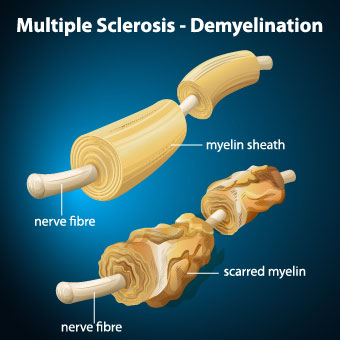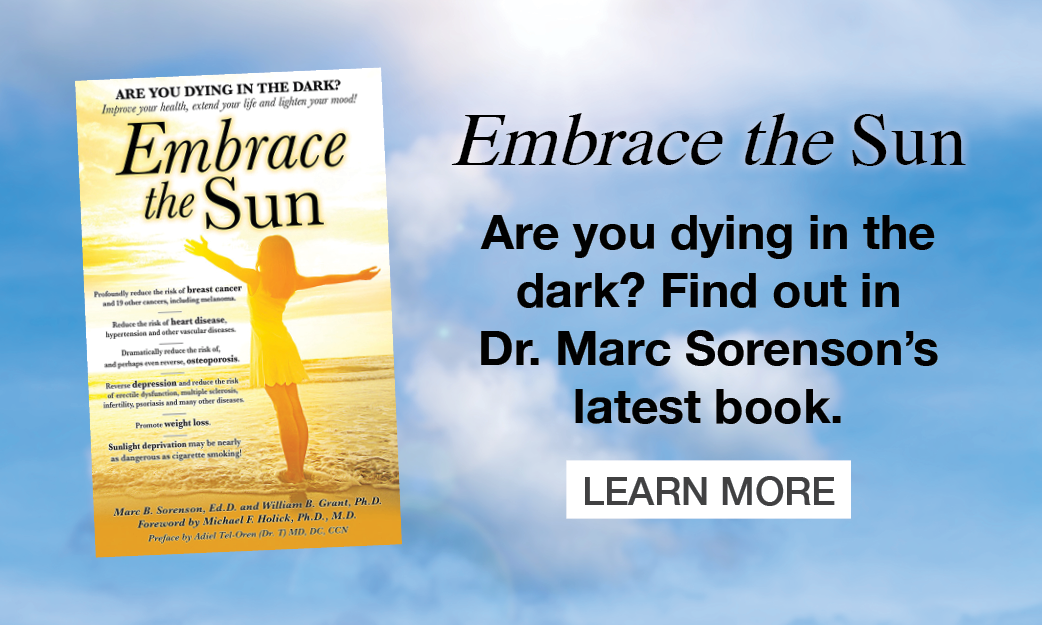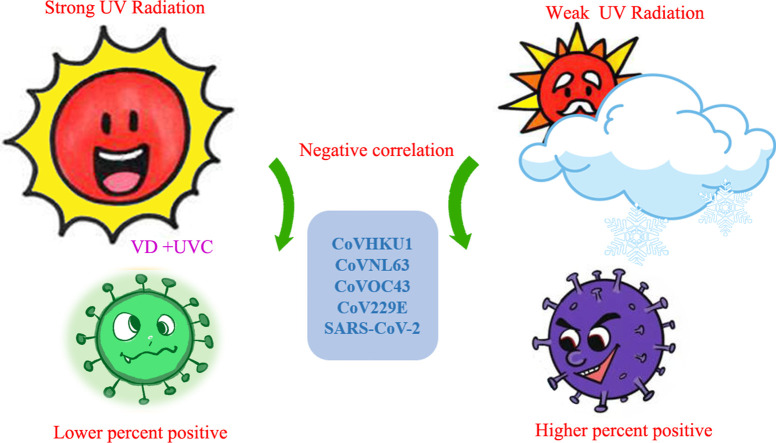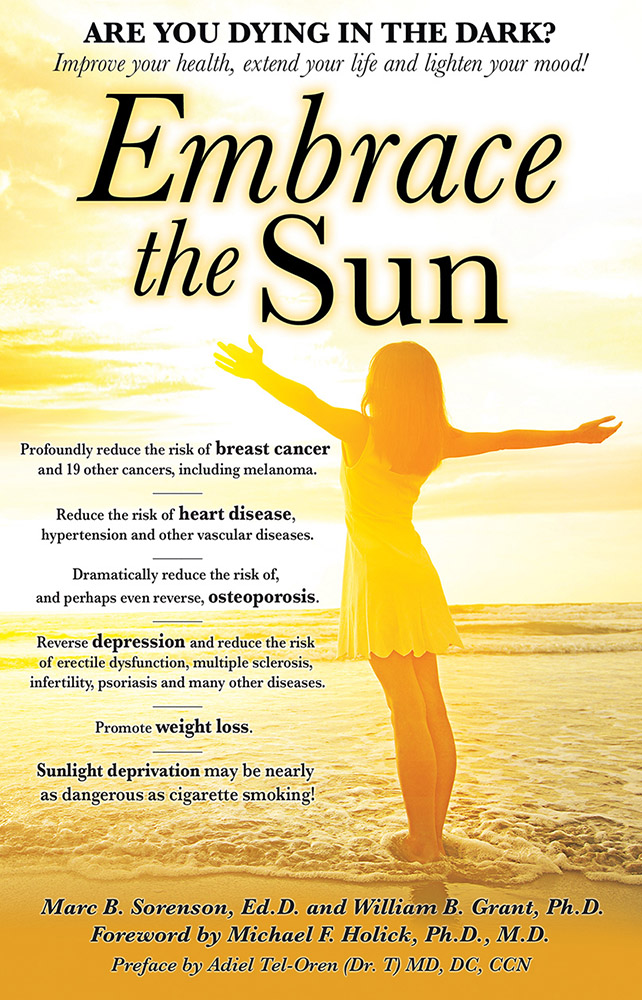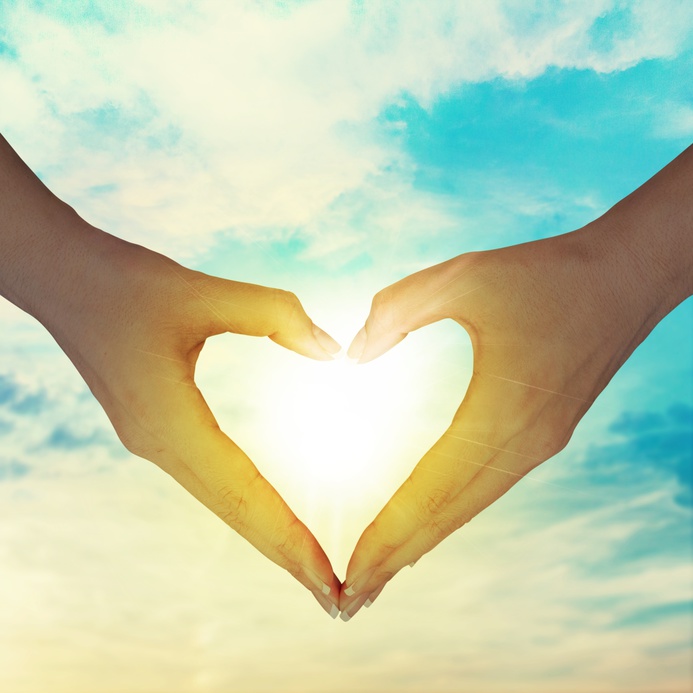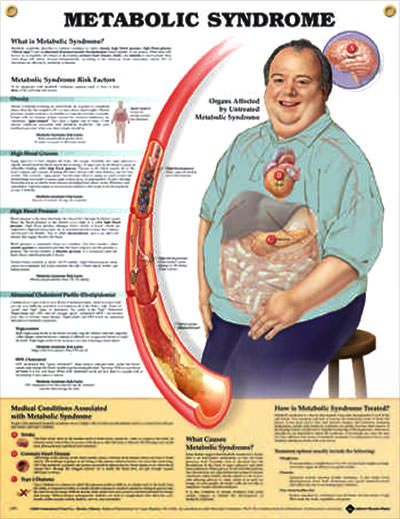Pediatric multiple sclerosis. Can sun exposure prevent it? By Marc Sorenson, Ed.D
Pediatric multiple sclerosis rarely receives much study since multiple sclerosis is a disease that usually develops in young adulthood. That lack of research is a mistake and may be leading to unnecessary death and disability. Simple sun exposure may diminish or eliminate the disease. So how many children’s (and young adults’) lives have been destroyed by problems caused by this insidious disease? In addition, could proper use of heliotherapy (sun treatment) prevent the disease? I opine that this disease follows the admonition: “An ounce of prevention is worth tons of cure.”
What is pediatric multiple sclerosis?
Multiple sclerosis is an autoimmune disease in which T-cells initiate an inflammatory response against myelin, the protective cover of nerves. In other words, the immune system attacks itself and leads to terrible destruction. This process, known as demyelination, leaves the nerves bare and susceptible to “short circuiting.” From 85 to 170 people per 100,000 in the USA suffer from MS. In addition, women’s risk, from 1991 through 1994, increased by 50% compared to the period from 1982 through 1986.
Multiple sclerosis affects about 400,000 Americans and about 2.5 million people worldwide. There may also be many more yet-undiagnosed cases of MS in the population. Pediatric multiple sclerosis occurs in babies and children.
What does the research show about sunlight and pediatric multiple sclerosis?
A study presented in the virtual Americas Committee for Treatment and research in Multiple Sclerosis Forum 2021, has stunning implications. The meeting, known as ACTRIMS, had many important findings. Probably, the most important finding had to do with sunlight and pediatric multiple sclerosis. A medial student at the Australian National University in Canberra, Prince Sebastian, presented investigation and results:
“Low Sun Exposure is a Risk Factor for Pediatric-Onset Multiple Sclerosis,” was the title of the research. It found that spending at least 30 minutes in outdoor sunlight daily associated to a significantly reduced risk factor for pediatric multiple sclerosis.
More information on the research.
The study used 16 pediatric centers. There were 332 children with pediatric-onset multiple sclerosis who formed the subjects. Another 534 healthy children served as controls for purposes of comparison and conclusion. Researchers analyzed associations between time spent outdoors in the summer (sun exposure) between subjects and controls. Thus, they were able to compare the risk of pediatric multiple sclerosis to amount of sun exposure.
The conclusions were remarkable. The investigators compared children who spent less than 30 minutes outside to those who spent up to more than an hour outside. Those who spent more time outside had a 2.6 times lower risk of pediatric multiple sclerosis. Most noteworthy, however, was that spending one-two hours outside predicted a 7.4 times lesser risk of the disease!
It would be difficult to argue with this study.
The message it sends is that sunlight is a gift to mankind. In addition, do not engage in child abuse by keeping children out of the sunlight!
For vital information on sunlight, multiple sclerosis and health, visit sunlightinstitute.org and read the book, Embrace the Sun.
Sunlight and food allergies are negatively associated. By Marc Sorenson, EdD.
Do certain foods cause you to break out in hives, or cause pain and discomfort? Then you may have an allergy and thus a hypersensitivity to the food. An allergy is a damaging immune response to a particular substance, to which the body is hypersensitive. In addition, in the case of anaphylaxis, it can be deadly. Sunlight and food allergies relate closely to each other, that is, in a good way. Hence, sunlight may have a place in stopping the allergic reactions.
A review of research on vitamin D, sunlight and food allergies makes some interesting statements. [1] First of all, the researchers state that since 2007, most epidemiologic studies have supported low sunlight, as a risk factor for food allergy. They then note that studies that looked directly at vitamin D status as measured by serum vitamin D levels are not nearly as consistent as studies on sunlight and food allergies. They state: “Although conflicting, the vitamin D studies suggest a more complicated association than a linear dose response in all individuals…”
However, sunlight exposure produces a different outcome for allergies.
Their summary is telling: “Many studies have linked sunlight with the development of food allergy. “However, whether this [directly relates] to vitamin D status or other sunlight-derived, seasonal and/or geographic factors remains uncertain. More studies are needed to investigate the role of sunlight and vitamin D status in food allergy because of their potential for primary prevention and disease modification.” Sunlight and food allergies may have a negative association. If more sunlight is available, fewer food allergies may occur.
This is another of those scientific papers that illustrates that sunlight exposure is nearly always protective against the studied disease. Yet, there is much more room for argument when vitamin D serum levels are used.
It is sunlight, not vitamin D, which makes the difference.
My takeaway? Sunlight and food allergies, since they are negatively related, speak to the importance of obtaining sufficient time in the sun. Get sufficient exposure to non-burning sunlight on a regular basis. That will provide plenty of vitamin D when one needs it. In addition, it also provides nitric oxide, endorphins, serotonin, dopamine, BDNF and other photoproducts yet unnamed. Thus, we must cease to equate sunlight exposure only with vitamin D. If vitamin D is our goal, and we neglect sunlight, we do a disservice to other healthful effects of sunlight. Furthermore, we must understand that a pill can never replicate the magnificent and essential powers of the sun.
Be sure to obtain your share of non-burning healing sunlight. For more information on the healing powers of sunlight, visit https://sunlightinstitute.org/. In addition, read the book, Embrace the Sun.
Diabetes and sunlight. Is there a connection? By Marc Sorenson, EdD.
Diabetes associates with sunlight. Yet, please understand that lack of sunlight is not the primary cause of the disease. Nevertheless, sun exposure can act as an adjunct to the primary healing methods, which are nutritional changes and more exercise. My wife and I saw first hand, the efficacy of sunlight and good nutrition. During our 15 years at our former health institute, our clients lost more than 100 tons of fat. In addition, two-thirds of diabetic guests were free of all medication in less than two weeks. If clients stayed four weeks, there was about an 85% cure rate, and the remainder profoundly lowered medication. Sunny Southern Utah furnished the sunlight; we furnished the nutrition, exercise and expertise.
What is diabetes?
Diabetes is a disorder of chronically high blood glucose and it leads to blindness. It also leads to nerve damage, heart disease, kidney disorders, neuropathy and other maladies. Furthermore, it is so deadly that some experts believe it will ultimately destroy our health care system. Due to a change to a high fat, junk-food diet, this destruction of health care presently exists in China. In addition, diabetes was the seventh leading cause of death in the United States in 2017. Thus, 83,564 death certificates listed diabetes as the cause of death. Furthermore, it is important to understand that death certificates underestimate the carnage effected by diabetes. Most noteworthy is that diabetes contributes to far more than 83,564 deaths. Therefore, when researchers listed diabetes as the underlying or contributing cause of death, the number of deaths skyrocketed to 270,702.
Two forms of the disease: Both associate with lack of sunlight.
Diabetes comes in two forms: (1) Type-one diabetes occurs due to autoimmune response, thus damaging the insulin-producing islet cells. This damage consequently reduces production of insulin, which is responsible for removing glucose from blood and storing it in tissue. Only about 5% of diabetics are type-one. (2) Type-two diabetes, in which there is sufficient insulin, yet blood glucose remains high due to insulin resistance. This discussion involves type-two.
Most noteworthy, as with heart disease, a paucity of sunlight is not the primary cause. Rather, deleterious nutrition habits are the main reasons. These habits are principally high meat consumption, sugar consumption, egg consumption, low consumption of fruits and vegetables, and too many fried foods. In the case of type-one diabetes, milk consumption is probably the most important nutritional factor. Yet, sunlight may act as a prophylactic against both types of the disease. Especially relevant is that diabetes probably does not kill someone directly. Rather, it is the diseases resulting from diabetes, which lead to death.
The influence of sunlight on this disease.
There are several studies showing a relationship between type-two and sun exposure. Hence, one paper showed that blood-sugar levels were lower during summer, indicative of a protective effect of summer sun. Another, a meta-analysis, produced moderate evidence that recreational sun exposure associates with a reduced risk of type-two . The study materialized because the researchers observed that higher vitamin D levels associated with lower diabetes risk. Yet, vitamin D supplementation did not associate with lower risk. They hypothesized sun exposure could have influences unrelated to vitamin D, and such seems to have been the case.
Perhaps the most important investigation showed that women who had “active sun exposure habits” had a 30% decrease in the risk of type-two diabetes. It seems like being a regular participant in sunny activities is a good idea, no? Therefore, enjoy regular, non-burning sun exposure, avoid junk foods and prevent or heal this disease.
For more information on sunlight and health, visit sunlightinstitute.org. In addition, read my book, Embrace the Sun.
Happy Sunning!
Sunlight and pandemics-more interesting information about our magnificent Sun, by Marc Sorenson, EdD.
Sunlight and pandemics link together closely—more sunlight, fewer pandemics. This is because it is our “best disinfectant.” Unobstructed sunlight kills viruses and bacteria outside the body and strengthens the body internally. Sunlight has been preventing diseases throughout history. That is probably why the sun was a deity in some ancient societies. More recently, scientists have been telling us for decades how important sun exposure is, and they continue to do so.
Perhaps it is time to listen!
Thus, research early in 2020, from the DHS, showed that “simulated sunlight” rapidly decayed the Covid-19 virus. The researchers tested effects of sunlight on Covid-19 viruses in aerosols—suspensions of solid particles and liquid droplets in air. These aerosols are a potential route of disease transmission through inhalation. Consequently, when sunlight exposure accelerates the decay of these viruses, it prevents an avenue of human-to-human transmission. Thus, the breathing in of these “decayed” viruses, usually coughed, sneezed, or exhaled, ceases to be lethal. Therefore, sunlight outside the body inactivates the viruses due to rapid decay. In other words, it kills them before they can do damage.
Sunlight and pandemics also link internally through vitamin D production.
Vitamin D, produced by skin during sun exposure, also inhibits some of the powerful disease reactions and makes pandemics less deadly. The cytokine storm is one of those reactions. It may lead to death by causing inflammation and subsequent pneumonia. A cytokine is a specialized protein molecule that attacks and destroys infected tissue. These proteins can be either pro-inflammatory of anti-inflammatory. For our purposes, we will discuss pro-inflammatory cytokines.
How does the cytokine storm work?
Usually, the cytokines needed to fight the infected tissue, cease their attacks and diminish after they have won the battle. However, in the case of a disease like influenza (or Covid-19), “friendly fire” occurs. The immune system recruits millions of reinforcing cytokines, and those cytokines mount an overwhelming attack against tissue they initially protected. In other words, they cause a violent storm. Cytokine storms lead to severe inflammation that weakens or destroys blood vessel membranes in the lungs and other tissue. As a result, fluid seeps through to the air sacs, which leads to pneumonia. People thus end up drowning in their own body fluids. Dr. Angela Rasmussen describes it: “Basically you’re bleeding out of your blood vessels.” She goes on to say the problem may not end there. The storm spills into the circulatory system and can create systemic issues across multiple organs.
How does vitamin D dampen the storm?
Vitamin D leads to the production of cathelicidins and defensins, which are peptides (proteins) with antimicrobial properties. According to Dr. William Grant and colleagues, these peptides lower viral replication rates and reduce concentrations of pro-inflammatory cytokines. As already mentioned, these pro-inflammatory cytokines produce the inflammation that injures the lungs. Nevertheless, the damage does not necessarily end in the lungs. Recent research shows that the damage from Covid-19 can spread to multiple organ systems.. The report on this research suggests the cytokine storm may be responsible for that spread. The heart, liver, kidneys, neurological system and gastrointestinal tract may all be targets of Covid-19.
If what I posit is true, we would expect Covid-19 to be higher in populations with high vitamin D deficiency, and such is the case.
Henry Lahore, one of the great vitamin D scholars, has listed four racial groups with disproportionately high vitamin D deficiency: Elderly Italians, Spanish, Swedish Somalis and African Americans. Mr. Lahore furnishes invaluable information regarding race, vitamin D, sunlight and Covid. Many of you have read of the alarmingly high Covid-19 death rate in African Americans. From my previous research, I know that African Americans also have alarmingly low vitamin D levels. Lahore also cites research that shows 84% of African Americans are vitamin D deficient. In addition, in Chicago, 70% of Covid 19 deaths are among Blacks. The reason for the deficiency? Dark skins take much more time in the sun to produce vitamin D.
Unfortunately, our answer to Covid-19 has been to cocoon everyone indoors.
The lockdowns assure that no one can obtain vitamin D except by supplement. That is, unless they are fortunate enough to own sunlamps and sunbeds (tanning beds). Even more alarming is the fact that the Swedish Somali population has 40% of the deaths in Sweden. Yet, they comprise only .84% of the Swedish population. Therefore, the Dark-skinned Somalis have 4,700% greater risk of death from Covid 19! This can only be due to lack of sufficient sunlight and subsequently, low vitamin D. No such death risk exists in Africa, where sunlight is ubiquitous. Thus, the answer for all Americans is to obtain plenty of non-burning sun exposure year around, or use a sunbed.
More common sense about sunlight and pandemics from Richard Hobday, researcher and writer.
First of all, to understand this section, you must know that the flu pandemic of 1918 killed approximately 50 million people. Mr. Hobday explains this in an important paper from 2020, entitled Coronavirus and the Sun: a Lesson from the 1918 Influenza Pandemic
Here are his most impactful points regarding sunlight and the 1918 pandemic:
Medical personnel found that patients nursed outdoors recovered better than those treated indoors.
- Outdoor air is a natural disinfectant. Fresh air can kill flu viruses and other germs.
- In the 1918 pandemic, overcrowding and bad ventilation put soldiers and sailors at high risk of catching influenza.
- Most of the victims of the pandemic did not die from influenza: they died of pneumonia and other complications.
- Hospital personnel placed sick soldiers outdoors to breathe fresh air [and of course, sunlight]
- Open-air treatment reduced deaths among hospital patients from 40 percent down to about 13 per cent.
Of course, in 1918, the efficacy of sun exposure and vitamin D was unknown.
So now, we know. Low sunlight links to high pandemic risks. More sunlight and fresh air produce a better chance of surviving the pandemic we currently face.
It seems like nature knew a better way more than 100 years ago. Safely enjoy non-burning sun exposure or sunbed exposure regularly.
Happy Sunning!
To learn more about the marvelous curative powers of sunlight, visit Sunlight Institute and read the Book, Embrace the Sun.
MS is associated closely with lack of sun exposure and low vitamin D levels. So what is new? By Marc Sorenson, EdD
MS is a disabling autoimmune disease.
MS is an autoimmune disease in which T-cells initiate an inflammatory response against myelin. This process, known as demyelination, leaves the nerves bare and susceptible to “short circuiting.” As a result, communications between brain and body suffer damage. Eventually, the disease causes irreparable deterioration of nerves. Some of the effects of MS include numbness and weakness in limbs. In addition, there may be lack of coordination, loss of vision, lack of mobility, slurred speech and numerous other disorders.
What do we know about the connection between sun exposure and MS?
Sunlight is an immunomodulator. In other words, it may affect the functions of the immune system. In the case of an autoimmune disease, it may stop the immune system’s attack on its own tissue. Because sunlight stimulates the production of vitamin D in skin, it may suggest that vitamin D is protective. In addition, it also suggests the incidence should diminish in areas of high sun exposure, and increases in areas of low exposure.
Thus, the risk of MS in far northern areas is 100 times greater than in equatorial areas.
In equatorial areas, sunlight is intense, and the risk of the disease approaches zero. Another interesting study of immigrants to the UK (low sunlight), but born in the sunny West Indies is enlightening. Especially relevant is that these immigrants had one-eighth the rate of MS as their own children born in the UK. It therefore appears that childhood sun exposure provides protection against the disease.
Where does vitamin D fit?
While it is tempting to chalk up the association of low MS to high vitamin D (as mentioned above), use caution. As with certain other diseases, sun exposure may have a positive influence on MS, independent of vitamin D. For example, a study on animals assessed the relative affect of sunlight and vitamin D on the diseaase. The researchers concluded, “These results suggest UVR [sun] is likely suppressing disease independent of vitamin D production.” They also stated that vitamin D supplementation alone might not replace the ability of sun (UV) to reduce MS susceptibility.
Another more recent study found similar results.
The investigators used animals that had no vitamin D receptors (VDR), and therefore could not produce vitamin D. Therapy with UV light suppressed the disease. The investigators concluded that UV light suppression of MS occurs in the absence of vitamin D production.
Another recent investigation: High sun exposure and high vitamin D both associate with lessened severity of MS.
This study investigated the severity of the disease among people who already had MS. Thus, it was a unique study, to my knowledge. The investigators used the subjects’ latitude (a marker for sun exposure and vitamin D levels) and compared it to MS severity. Interestingly, high sun exposure and high vitamin D levels associated to a reduction in MS severity. However, the investigators listed only sunlight as a sure factor in reducing MS severity.
Hence, the investigators stated three salient points in their paper.
- “Observational studies suggested vitamin D-dependent effects, but prospective supplementation studies have so far been inconclusive….”
[This is an important, and a wake up call. Those who believe that we need only swallow a handful of pills, as we avoid the sun, are sadly mistaken. There is no way we can determine if high vitamin D blood levels are the reason for a reduction in MS severity. That is, unless we produce those levels in a scientific, controlled study using supplementation.]
- “Although [low] vitamin D cannot be proven as the causal factor, we provide evidence for clinically relevant effects of sunlight exposure.
- ”Furthermore, this study suggests sunlight triggered pathways other than vitamin D could play additional and modulatory roles as well.”
There you have it.
High sunlight exposure decreases the severity of multiple sclerosis. Vitamin D, though it is a miraculous nutrient, probably has little or no effect on the disease.
HAPPY SUNNING!
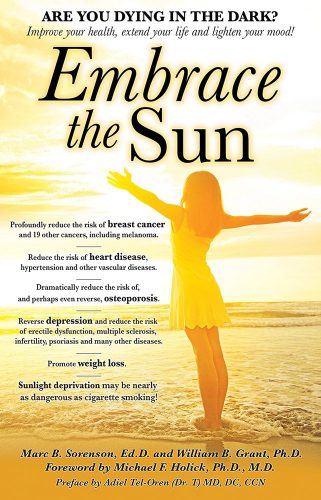 You can find much more information on sun exposure and MS at sunlightinstitute.org. Also, read the book, Embrace the Sun.
You can find much more information on sun exposure and MS at sunlightinstitute.org. Also, read the book, Embrace the Sun.
Fishermen receive skin protection through sun exposure and vitamin D, by Marc Sorenson, EdD.
Fishermen in Brazil spend plenty of time on the sea and have healthy skin. Furthermore, they soak up vast quantities of direct sun exposure. Thus, should we expect them to succumb to incredibly high rates of skin cancer? No! Does this seem like a paradox? It should not. It is the perfectly natural outcome of plenty of non-burning sun exposure. This will seem clear to you if you have read my book, Embrace the Sun.
Recent research from Brazil produced some large and fascinating surprises. In addition, it changed a few minds regarding knowledge of sunlight’s healthful qualities. First of all, it illuminated sunlight’s protective effects against skin cancer, particularly in fishermen.
So how much sunlight do fishermen in Brazil soak up daily?
Due to their profession, commercial fishermen chronically expose themselves to sunlight. So, in this research, they had soaked up Brazilian sunlight for more than 15 years. The average exposure time was 21 to 28 hours weekly! Consequently, these fishermen received a sunlight dose 6-8 times higher than indoor workers did. Therefore, you might surmise that they used lots of sunscreen. Yet they did not. It is especially relevant that 62% of this population of fishermen used none. Must we therefore conclude that they suffered exceptionally high skin cancer risk? No. The frequency of skin-cancer diagnoses was 2.7% of the study population of 174 fishermen (and fisher women). The researchers stated, “There was a low prevalence of diagnosed skin cancer among the fishermen when compared to the general population.”
So there you have it. The general population, with comparatively little sun exposure, suffers from a high skin cancer risk.
Yet, fishermen practically bake in the sun every day, and have a minuscule risk of skin cancer. This paradox should be easily understood. Sun exposure is a superb prophylactic against skin cancer and most other cancers if used regularly and safely without burning. Remember that it causes the body to produce vitamin D, which may also provide protection against skin cancer.
For more information on sunlight and health, visit sunlightinstitute.org and read the book, Embrace the Sun.
HAPPY SUNNING!
More sunlight, less covid 19 by Marc Sorenson, EdD.
More sunlight, I said at the onset of Covid-19 (also known as SARS-Cov-2), would be associated with a reduced incidence disease and death. In addition, I stated the disease would make a remarkable resurgence in fall and winter, as availability of sunlight diminished. For that statement, some praised my perspicacity, and others derided my intelligence. I lost some friends on social media and had to unfriend others.
For our purposes, it is important to understand that there are several coronaviruses, and each causes its particular disease manifestation.
In addition, with the possible exception of Covid-19, these viruses are seasonal. Thus, the incidence rates are higher in winter and lower in summer. Could sunlight exposure be the key to the seasonal relationship? Especially relevant, of course, is that Covid-19 was non-existent at the time the other viruses proved their seasonality. It now appears, however, that Covid-19 is indeed seasonal. Thus, I believe that sunlight drives that seasonality.
So what do we to obtain more sunlight now that winter has arrived?
I suppose it is self-serving to say, “I told you so.” Yet indeed, I did make my prediction, and it was correct. It would have been even more correct if people were encouraged to seek the sun rather than suffer through sunless lockdowns. There is now scientific corroboration that more sunlight associates with less death and disease from Covid-19 and other coronaviruses. Recent research (already dated for 2021), substantiates my ideas on sunlight and Covid-19. In this study, the investigators assessed sunlight available from April 17-July 20, 2020 in various U.S. geographical zones. Then, they compared sunlight availability to the risk of Covid-19 and four other coronaviruses in different areas of the U.S. The graphical abstract they presented is below and makes the same point that I made months ago.
In areas of strong UV radiation (more sunlight), there was much less risk of testing positive for Covid-19 and the other coronaviruses.
Obviously, people need more sunlight to help protect themselves from Covid-19 and other viruses. Obtaining more sunlight works in at least two ways against Covid-19.
1. Research from the CDC shows that sunlight rapidly kills Covid-19 in aerosols.
Aerosols are suspensions of solid particles or liquid droplets in air. They are potential routes for disease transmission. Sunlight is also able to kill Covid-19 on surfaces.
2. More sunlight exposure causes the skin to produce more vitamin D
. Vitamin D inhibits the overproduction of cytokines, specialized protein molecules that attack and destroy infections. Usually, the cytokine needed to fight the infected tissue stops its attack after it has won the battle. However, in the case of a disease like influenza (or Covid-19), “friendly fire” occurs. The body’s immune system recruits innumerable “extra” or reinforcing cytokines, and those cytokines mount an overwhelming attack against the tissue they initially protected; in other words, they cause a cytokine storm.
Cytokine storms lead to severe inflammation that weakens or destroys blood vessel membranes in the lungs.
This causes fluid to seep through to the air sacs, which leads to pneumonia. A person then ends up drowning in his/her own body fluids. Dr. Angela Rasmussen describes it thus: “Basically you’re bleeding out of your blood vessels.” She goes on to say that the problem may not end there. The storm spills into the circulatory system and can create systemic issues across multiple organs.
Vitamin D, through various mechanisms, retards and stops cytokine storms.
Thus, sun exposure is a two-edged sword: (1) it kills Covid-19 outside the body. (2) It causes the production of vitamin D and can stop the cytokine storm.
So in winter, when there is little sunlight available, and virtually no production of vitamin D, what shall we do?
When there is insufficient sunlight, it is essential to find another source of light that will also produce vitamin D. Sunbeds are the ideal source of the light we seek. Research shows that sunbed users (tanning bed users) in Canada and the U.S. have higher vitamin D levels than any other demographic.
I own a sunbed and go to salons when traveling. This winter, I plan to use my sunbed regularly. In my opinion, it is the best protection against the sunlight deficiency experienced in winter.
For more information on the healthful benefits of sunlight, visit https://sunlightinstitute.org/ and read the book, Embrace the Sun.
Happy sunning!
Memory, learning and sunlight by Marc Sorenson, Ed.D
Memory becomes a worry as humans age, and that worry has spawned a plethora of new anti-forgetfulness products. Based on recent research, we elucidate the manner in which sunlight stimulation of skin may influence important chemical reactions. These reactions improve memory and cognition.
For the purpose of this article, it is necessary to understand the meaning of three terms:
- Urocanic acid (UCA): a crystalline acid normally present in human skin, it may play a part in skin protection.
- Histidine: a basic amino acid that acts as an intermediary between UCA and glutamate
- Glutamate: a chemical that functions as a neurotransmitter and excites cells of the central nervous system
You are probably already forming your own opinion regarding the interaction of sunlight and memory. Let us expatiate on that interaction and unravel a hitherto unknown mystery.
The authors of the aforementioned research noted that seasons of sunlight associated with moderate improvement to physical and mental states. Some conditions you may be familiar with, because we have discussed them at length in these blogs. A few of them are seasonal affective disorder (SAD), bipolar disorder, and depression. Nevertheless, what makes the research so interesting is that it sought answers regarding why sunlight seemed to enhance learning and memory. Moreover, it found a brand new answer.
Because the researchers explored brain neurons to unlock the mystery, they found that UCA existed in many brain regions. This was not something that they had encountered previously, and thus it piqued their curiosity. No other investigators had reported finding UCA in the central nervous system. Yet, they knew UCA was prevalent in skin. Therefore, knowing that sun exposure to the skin produced many photoproducts, they tested a new hypothesis. That hypothesis was that UCA produced by sunlight could be the link that ties sunlight to memory.
How the researchers conducted the experiment
After exposing rats to low-dose UVB exposure (similar to sunlight or sunbed exposure), they observed increased UCA levels in the serum. Moreover, they observed the same increase in UCA levels within the neurons (nerve cells) of the cerebrospinal fluid. Furthermore, they were able to produce the same increases in UCA brain levels by intravenous injection of UCA. This suggests that UCA may cross the blood/brain barrier and enter brain neurons. The authors of the above-cited research stated that UCA is an intermediate part of a conversion of histidine to glutamate. The following graph describes the sunlight>UCA>glutamine>memory connection. (from the authors)
Glutamate, as mentioned, excites neurons in the brain. What better way to improve memory?
To test their hypothesis with “mouse memory,” the investigators assessed the ability of the animals to stay on a moving device called a rotarod. In addition, they observed that administration of both UCA and UV exposure enhanced the performance of the animals.
The bottom line regarding sunlight and brain function
Sun exposure improves memory, and UCA (with glutamate) appears to be one of the mechanisms responsible for that improvement.
Happy sunning!
For more information on the health benefits of sunlight, visit the Sunlight Institute and read the book, Embrace the Sun.
Latitude, sunlight, and covid-19 by Marc Sorenson, EdD
Latitude, when compared to disease and disability, is an attention catcher. First of all, why would latitude be important? Is it because latitude itself creates disease? Is it because different latitudes lead to different temperatures? Could it be different distances from the magnetic poles are involved in human physiology? No, none of those answers is correct, yet, there is a simple answer to the link between latitude and disease. That answer is sunlight and vitamin D. Low latitudes (closer to the equator) receive much more sunlight, and sunlight is more direct much of the year.
A study of latitude backs the efficacy of sunlight, and possibly vitamin D, on reducing the risk of Covid-19. This was a large, study, drawing reliable data from 88 countries. The researchers compared the countries for Covid-19 death rates and then compared them for the latitude.
The results of Covid-19 death rates compared to latitude.
Highly significant, positive correlations were found between lower mortality rates from Covid-19 and a country’s proximity to the equator. The researchers stated that their evidence suggested a direct correlation between sun exposure and reduced mortality. They also assumed that vitamin D was the photoproduct of sunlight that lowered the risk of Covid-19.
This was a good, timely study in that it established sunlight as a prophylactic for covid-19. Many studies had previously mentioned vitamin D as the primary blood measure to reduce risk of the Covid-19, but none has mentioned latitude as a factor to furnish proof. In addition, neither does this study really furnish proof. That is because the only study that will prove the relationship would be a vitamin D-supplement study.
Other research,which links vitamin D levels to reduced Covid-19 mortality, but does not mention latitude as a factor.
Another recent study on the association of vitamin D levels to covid-19 survival shows promise for vitamin D. It states that fourteen observational studies show that high D levels inversely correlate with the incidence or severity of Covid-19. Yet, we should always remember that sun exposure on skin produces 90% of the vitamin D levels in most populations. Furthermore, 20 minutes of full-body summer sun exposure at midday produces up to 20,000 IU of vitamin D.
Finally, a word about sunbeds (tanning beds)
Finally, realize that sunbeds (tanning beds) produce vitamin D and enhance health. In addition, it is likely they would also reduce Covid-19. Sunbeds produce vast quantities of vitamin D. People in Canada who use sunbeds have the highest levels of vitamin D in the country, especially in winter. Moreover, a 20-year study demonstrated that both sun exposure and sunbed exposure reduced the risk of death. Women who used sunbeds were 23% less likely to die from any cause than women who did not use them. Another advantage is that latitude does not matter with sunbed use.
From the available research, it is evident that sunlight and vitamin D are protective against Covid-19. Sunlight exposure at midday, or sunbed use, are always the best sources, since sunlight exposure produces many health benefits beyond vitamin D.
For more information on the benefits of sunlight, visit Sunlight Institute, and read Dr. Marc Sorenson’s book, Embrace the Sun.
Vitamin B3, other lifestyle factors and skin cancer, by Marc Sorenson, EdD
Vitamin B3 is not a topic I expected to find while checking out the latest on nutrition and skin cancer. Consequently, it surprised me that research showed an impressive effect of vitamin B3 on protection against non-melanoma skin cancers (NMSC). NMSC are also known as squamous and basal cell carcinomas (SCC and BCC). The protection occurs against UV (ultraviolet) light, which researchers claim is the prime factor causing squamous and basal cell cancers. In the aforementioned study, treatment with vitamin B3, 24 hours before exposure of skin to UV, reduced oxidative stress significantly. It also had the ability to repair DNA damage. This is another study demonstrating that sunlight is not the enemy. Rather, NMSC is due to a combination of factors, including environmental toxins, poor habits of hygiene, smoking, and poor nutrition.
When the skin lacks protection, which is too often the case, then excessive sun exposure can cause damage and pain.
However, that is not what happens in a well-adjusted and well-cared-for life. Protection, whether by vitamin B3 or other additional healthful factors, can stop the damage. This may render sun exposure one of God’s greatest gifts to human health and wellbeing. Sun exposure is really only a minor factor in NMSC.
Here are factors beyond sunlight (and vitamin B3) that make a difference in this skin cancer:
Smoking predicts a higher risk of squamous cell carcinoma (SCC). After adjustment for sun exposure, age and sex, smoking predicts a doubling of the risk for SCC. In addition, there is a dose/response relationship between the number of cigarettes smoked and the risk of SCC. Such a relationship also exists among those whose diets lack green, leafy vegetables and whose consumption of meat and fat are very high. Vitamin B3 could be a nutritional factor related to low vegetable consumption and high meat and fat consumption.
Obesity is also an important risk factor for NMSC.
One study suggests that being obese changes the tumor microenvironment, due to the chronic inflammatory state that generally accompanies obesity. Furthermore, Cancer mortality maps also indicate that NMSC mortality is highest in regions with the highest obesity (https://www.cdc.gov/obesity/data/prevalence-maps.html). However, this is not true of regions with the highest sunlight exposure.
The message:
Lack of Vitamin B3 is a factor for an increased number of NMSC and probably for other cancers. Yet, it is only one of many factors that protect the skin. When poor nutrition and other deleterious lifestyle habits disappear, the risk of NMSC decreases. Let us not blame the sun! 
Happy sunning!
For more information on sunlight and health, visit sunlightinstitute.org and read the book, Embrace the Sun.

